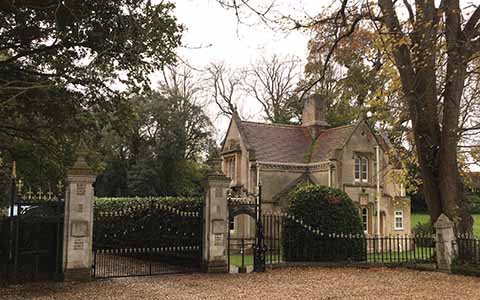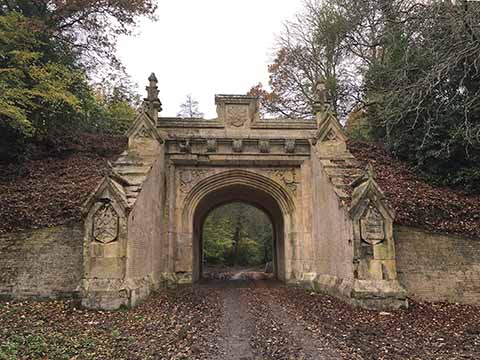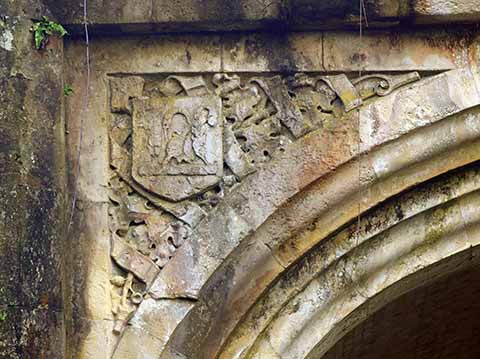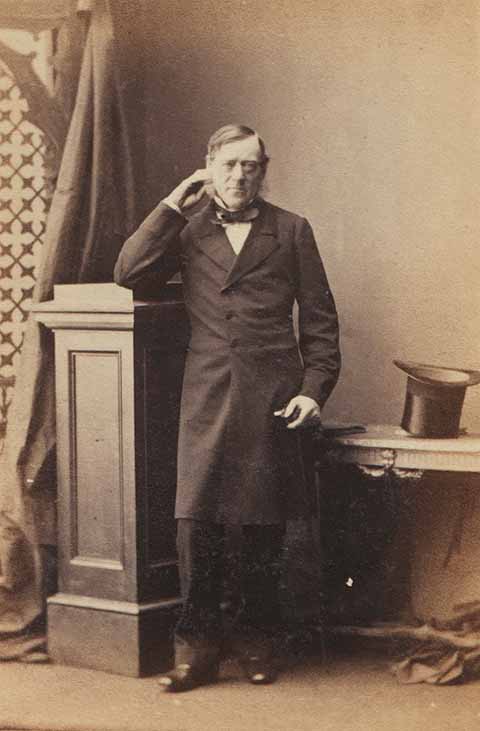A bridge called 77
Colin Divall recounts the history of Canford Manor’s ‘splendid archway under the South-Western Railway’
Published in December ’19
ANYONE WALKING from Wimborne along the Stour Valley Way cannot fail to notice the striking former railway bridge spanning the old carriage drive to Canford Manor, now a private school. Once prosaically known as Bridge 77, it is now widely called Lady Wimborne’s (or the Lady Wimborne) Bridge. In engineering terms the structure is not particularly impressive but architecturally, matters are very different: as one of the most highly decorated railway bridges in the UK, it has been grade 2 listed since 1991. The heraldry is that of the Dowlais ironmaster, Sir (Josiah) John Guest, who bought Canford Manor in 1846 when the railway was being built and, with his extraordinary wife, Charlotte, had the house remodelled in 1848-51 by Charles Barry, architect of the Houses of Parliament. Barry also designed the bridge in 1853, to look something like the triumphal arches which often guarded grand country estates, impressing on visitors and passers-by the owners’ wealth and rank. The bridge certainly commanded attention and one contemporary newspaper waxed lyrical about ‘the splendid archway under the South-Western Railway lately erected on the estate by Sir Charles Barry’.
At first glance this looks like a straightforward case of new, industrial money making its mark as it bought its way into Dorset’s aristocracy. Indeed, more than one historian has suggested that Guest forced the railway company to build the bridge to satisfy his desire for social grandstanding. But there is little evidence for this. Even the official listing gives pause for thought – the name, ‘Lady Wimborne’s Bridge’, is puzzling since the aristocratic title did not exist until 1880! In fact, while Bridge 77 undoubtedly symbolised the Guests’ enormous wealth, its construction was something of a consolation prize, the resolution of a decade-long struggle to gain access to Wimborne station from the manor.
The story starts before the Guests’ arrival, around 1844 when Wimborne solicitor Charles Castleman started promoting the Southampton & Dorchester Railway to connect with London. One of the affected landowners was William Ponsonby, Canford’s owner by marriage since 1814; a Whig politician, he had become the first Baron de Mauley in 1838. Although neither very bright nor diplomatic, in July 1845 he was elected chairman of the Southampton & Dorchester’s board. The railway’s authorising act provided for a level crossing at Oakley, about a mile from the house, near where the parish road from the manor joined the turnpike towards Wimborne, giving reasonable access to the proposed station on the north bank of the Stour. However, Ponsonby was not happy with the inconvenience of a level crossing and got his fellow directors to promise to build a bridge under the railway instead. In August 1845 the railway’s engineer, Captain William Scarth Moorsom, was ordered to start despite the higher cost, around £1650. Even this was not enough for Ponsonby. By November he had got the board to move the station site next to the Oakley crossing. As this was very handy for the manor, it was agreed that the bridge could be abandoned.
Not surprisingly, all this caused uproar in and around Wimborne. A Mr Fryer – probably Frederick William Fryer, a local landowner and businessman well-connected to Castleman – organised a public meeting, a deputation to the board and letters to the London & South Western Railway, the line’s backers. Well-placed jibes that Ponsonby was acting purely in his own interests finally helped persuade the LSWR to insist in June 1846 that the station was moved back to its original site.
By this time John Guest had both become a member of the Southampton & Dorchester’s board and taken possession of the manor. Although he was content with the station being nearer to the town, he was no happier than Ponsonby about the level crossing. With the line’s construction well under way, the board was keen to resolve the matter. Between August and October 1846, it wrangled with Guest over whether he would accept additional railway facilities for the estate in lieu of the bridge, which the board still felt bound to provide.
The company was not trying to save money, but Guest (or perhaps it was Lady Charlotte, as at this point her husband was very ill and had serious business worries) could not make up his mind. At first he seemed amenable, so on 24 September 1846 the board agreed to spend the £300 it thought it would save by not building the bridge on ‘the erection of an arch as desired by Sir John Guest’s letter’, with any balance going on goods sidings at Oakley exclusively for the estate’s use. Exactly what Guest had in mind for an arch is something of a mystery – it was not a replacement for the crossing. Understandably, the board’s offer was conditional on there being no further delay. However, within a fortnight Guest had rejected the deal, so the board agreed to honour its promise to Ponsonby but replacing, at Guest’s request, the proposed bridge under the line with another one over it, located some yards south. This offer, too, was conditional on no further delay and also on Guest agreeing to buy the gatekeeper’s lodge which the company was already building by the level crossing. However, Guest was in no position to do the work which was needed on his estate to access the proposed overbridge. So when the railway opened in June 1847, it crossed the parish road at Oakley on the level, almost certainly guarded by the aesthetically rather superior lodge that survived there until the 1960s.

Just over the River Stour from Wimborne Minster itself is this rather smart gatehouse. The footbath by it leads to the bridge.
What has all this to do with Bridge 77? It is highly unlikely that the track, which later became the carriage drive, had been upgraded before the railway opened. The first bridge at the site was probably a simple timber span, like most on the line. But it is possible that in August 1846 the Guests were already thinking about making a carriage drive, with the proposed ‘arch’ mentioned in Sir John’s letter standing as a grand prelude to the estate. There is another possibility: that the arch was not a proper bridge but a ceremonial archway over the parish road at Oakley, marking the approach to the manor. Such an arch combined with the level crossing gates and lodge could have looked very similar to the ensemble designed by Barry and built around 1850 at the main entrance to the house. We shall probably never know for sure which, if either, of these possibilities was the truth.
The LSWR took over the Southampton & Dorchester in July 1848 and sometimes replaced level crossings with bridges. Not at Oakley, though. It is not clear when Guest finally abandoned his plan for the overbridge there. It is possible it was being referred to in December 1849, when the LSWR refused to fund a bridge on the Canford estate because it had already spent £406 on ‘the lodge’ at Oakley. Or perhaps Guest was at last planning the carriage drive and now wanted a replacement for the timber bridge. This seems unlikely, given that Wimborne Lodge, guarding the junction of the carriage road with the Wimborne-Poole turnpike, was not built until around 1853, about the same time as the replacement Bridge 77. It is more likely that the drive, its bridge and lodge were conceived, or at least more enthusiastically pursued, as one by Charlotte Guest after her husband’s death in November 1852.
The new bridge probably was not built until 1854 or even later, as the LSWR did not pay the contractor, Thomas Brassey, until March 1855. In any case, Barry’s highly ornate design of May 1853 was simplified, probably to save money – Charlotte Guest had agreed to refund Brassey’s fees but was quite hard up. The LSWR must have been delighted for it was under a legal obligation to lay another track , and this was one less bridge it had to rebuild when this happened, in 1863.
Even if the detail is obscure, Bridge 77’s history shows that Canford’s owners did not always get their way. Indeed, the railways spent little on accommodating them. The Oakley lodge was aesthetically a cut above the ordinary, but the extra cost, around £259, was not a huge sum to buy off a wealthy landowner, especially when that individual was a director! And the Guests? Presumably the family thought the bridge a worthwhile investment, marking their elevation into the aristocracy. However, Charlotte did not stay at Canford long enough to benefit much. She left in September 1856, just after her eldest son, Ivor Bertie, assumed ownership. Socially and politically ambitious, he became Baron Wimborne in 1880 on the recommendation of Disraeli, an early suitor of Charlotte’s, with Ivor’s wife, Cornelia Churchill, becoming Lady Wimborne. In the following decades, countless personages must have been impressed by the bridge as they were whisked to and from the station. Perhaps that is how it became known as Lady Wimborne’s Bridge. But lacking any evidence for this, ‘Lady Guest’s’ would seem a more appropriate name for Canford Manor’s ‘splendid archway under the South-Western Railway’.




